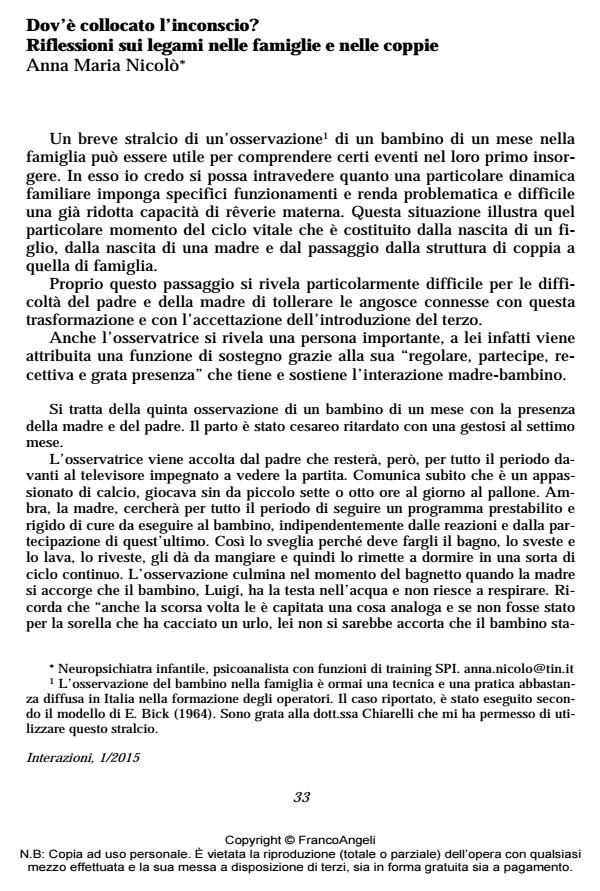The sites of the unconscious. Reflections on links in families and couples
Journal title INTERAZIONI
Author/s Anna Maria Nicolò
Publishing Year 2015 Issue 2015/1
Language Italian Pages 10 P. 33-42 File size 55 KB
DOI 10.3280/INT2015-001004
DOI is like a bar code for intellectual property: to have more infomation
click here
Below, you can see the article first page
If you want to buy this article in PDF format, you can do it, following the instructions to buy download credits

FrancoAngeli is member of Publishers International Linking Association, Inc (PILA), a not-for-profit association which run the CrossRef service enabling links to and from online scholarly content.
With the help of infant observation and of a clinical example taken from a diagnostic consultation the Author discusses the existence of different coexisting and interacting levels in the unconscious. These levels are not always accessible to representation but remain active providing orientation and directing our choices. We can assume that near our individual unconscious there is also an interpersonal unconscious that allows to see families as fantastic multi-dimensional organisms. In families at the most primitive level the differentiation between somatic and psychic states vanishes just like the distinction between self and other (Nicolò, 1988). In these dimensions a member can react with a somatic state or by acting to another member’s psychic state or dream or vice versa. In families we can see a group unit’s functioning organized as links that, despite being co-created by all family members, become capable of influencing those who produced them. My contention is that split off, dissociated or rejected aspects that remain at primitive non-verbal levels can still contribute to determine the family’s functioning organizing the links that each member co-constructs with the other in the course of time. The nature of the link is that of a new element in the relation, usually located on the background as the scenes on a stage that usually (except for pathological situations) do not dominate the set while the plot unfolds in the performance of actors.
Keywords: Sites of unconscious, individual unconscious, interpersonal unconscious, group unit’s functioning.
- Bateson G. (1977). Verso un’ecologia della mente. Milano: Adelphi.
- Beebe B., Lachmann F.L., Jaffe, J. (1997). Mother-infant interaction structures and presymbolic self and object representations. Psychoanalytic Dialogues, 7, 2: 133-182. DOI: 10.1080/1048188970953917
- Bick E. (1964). Note sull’osservazione del lattante nell’addestramento psicoanalitico. In: Bonaminio V., Iaccarino B., a cura di, L’osservazione diretta del bambino. Torino: Bollati Boringhieri, 2000.
- Ferro A., a cura di (2013). Psicoanalisi oggi. Roma: Carocci.
- Ferro A., Basile R., a cura di (2007). Il campo analitico. Un concetto clinico. Roma: Borla, 2011.
- Mazzacane F. (2013). Le vicissitudini del campo analitico. In: Ferro A., a cura di, Psicoanalisi oggi. Roma: Carocci.
- Nicolò A.M. (1988). La famiglia come matrice del pensiero. Terapia Familiare, 28: 5-16.
- Nicolò A.M. (1997). L’importanza diagnostica delle interazioni nella valutazione della famiglia e delle sue difese trans personali. Interazioni, 10, 2: 53-66.
- Nicolò A.M. (2000). La memoria nella trasmissione generazionale della famiglia. Psiche, 2: 111-122.
- Nicolò A.M. (2009). Subjectual links and transpersonal pathologies. Revue Internationale de Psychanalyse du Couple et de la Famille, 6, 2. www.aipcf.net
- Racamier P.-C. (1990). A proposito dell’ingranamento. Interazioni, 1992, 0: 61-70.
- Stern D.N. (1998). Le interazioni madre-bambino. Milano: Cortina.
- Winnicott W.D. (1956). La preoccupazione materna primaria. In: Winnicott D.W., Dalla Pediatria alla Psicoanalisi. Firenze: Martinelli, 1975.
- Gruppi di lettura per facilitare la comunicazione naturale tra genitori e bambini da 0 a 24 mesi Sara Micotti, in INTERAZIONI 2/2018 pp.94
DOI: 10.3280/INT2018-002008 - La morte di un fratello e le sue conseguenze sul funzionamento psichico familiare Massimiliano Sommantico, in INTERAZIONI 1/2019 pp.89
DOI: 10.3280/INT2019-001007
Anna Maria Nicolò, Dov’è collocato l’inconscio? Riflessioni sui legami nelle famiglie e nelle coppie in "INTERAZIONI" 1/2015, pp 33-42, DOI: 10.3280/INT2015-001004